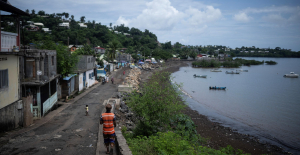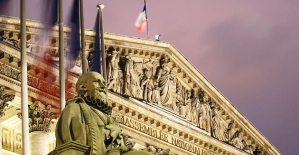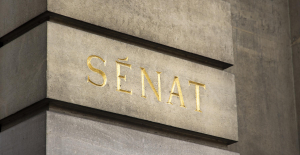Locked up slaves, blindfolded donkeys in a confined space: archaeologists have unearthed a “prison bakery” in the ancient city of Pompeii, destroyed in the year 79 by the eruption of Vesuvius.
These excavations carried out in a house made it possible to discover “a narrow room with no outside view, equipped with small windows with iron bars to let the light through,” the site located near Naples, in the south of Naples, announced in a press release. Italy. Archaeologists concluded that there was a “prison bakery, where slaves and donkeys were locked up and exploited to grind the grain necessary for the production of bread”. The research also revealed the presence of “engravings on the ground to coordinate the movement of the animals, forced to turn for hours while blindfolded”.
The house, currently being renovated, was “divided – as is often the case – into a residential area decorated with refined frescoes and a production area intended here for the production of bread,” the press release added.
In one of the rooms of the bakery, three skeletons had already been found in recent months, confirming that the house was inhabited. “We must imagine the presence of people with servile status whose owner felt the need to restrict their freedom of movement,” underlined the director of the Pompeii site Gabriel Zuchtriegel in a scientific article. “This is the most shocking aspect of ancient slavery, one devoid of both relationships of trust and promises of freedom, where one was reduced to brutal violence, an impression entirely confirmed by the securing of windows with iron bars.”
The volcanic ash spewed 2,000 years ago by Vesuvius sedimented on most of the homes of Pompeii, which allowed them to be almost completely preserved, as did many of the bodies of the 3,000 deaths caused by the catastrophe. Pompeii, a UNESCO World Heritage Site, is the second most visited tourist destination in Italy after the Colosseum in Rome.

 Gaza: under the spotlight, the Israeli-Palestinian conflict shakes up the Eurovision contest
Gaza: under the spotlight, the Israeli-Palestinian conflict shakes up the Eurovision contest Black soldier killed by a police officer in the United States: the sheriff publishes the video of the arrest
Black soldier killed by a police officer in the United States: the sheriff publishes the video of the arrest In Malmö, the Eurovision party transformed into entrenched camps
In Malmö, the Eurovision party transformed into entrenched camps In Russia, Vladimir Putin stigmatizes “Western elites”
In Russia, Vladimir Putin stigmatizes “Western elites” “Mediterranean diet” or “DASH”, two good tips for eating better
“Mediterranean diet” or “DASH”, two good tips for eating better Fatal case of cholera in Mayotte: the epidemic is “contained”, assures the government
Fatal case of cholera in Mayotte: the epidemic is “contained”, assures the government The presence of blood in the urine, a warning sign of bladder cancer
The presence of blood in the urine, a warning sign of bladder cancer A baby whose mother smoked during pregnancy will age more quickly
A baby whose mother smoked during pregnancy will age more quickly Artificial intelligence lies, cheats and deceives us, and that's a problem, experts warn
Artificial intelligence lies, cheats and deceives us, and that's a problem, experts warn Google Cloud mistakenly deletes UniSuper fund account and deprives 600,000 Australians of their superannuation
Google Cloud mistakenly deletes UniSuper fund account and deprives 600,000 Australians of their superannuation IBM, Amazon, Hager... These record investments expected at the Choose France summit
IBM, Amazon, Hager... These record investments expected at the Choose France summit Boeing's black streak: a second Air France flight diverted in three days for “a smell of heat”
Boeing's black streak: a second Air France flight diverted in three days for “a smell of heat” Eurovision 2024: Bernard-Henri Lévy will vote for the “courageous” Eden Golan in the face of “the wind of hatred against the Jews”
Eurovision 2024: Bernard-Henri Lévy will vote for the “courageous” Eden Golan in the face of “the wind of hatred against the Jews” Eurovision 2024: Joost Klein, the Dutch candidate, excluded from the competition
Eurovision 2024: Joost Klein, the Dutch candidate, excluded from the competition The origin of the vandalized world, the Musée d’Orsay files a complaint
The origin of the vandalized world, the Musée d’Orsay files a complaint London: two octogenarians charged after damaging the “Magna Carta” window
London: two octogenarians charged after damaging the “Magna Carta” window Omoda 7, another Chinese car that could be manufactured in Spain
Omoda 7, another Chinese car that could be manufactured in Spain BYD chooses CA Auto Bank as financial partner in Spain
BYD chooses CA Auto Bank as financial partner in Spain Tesla and Baidu sign key agreement to boost development of autonomous driving
Tesla and Baidu sign key agreement to boost development of autonomous driving Skoda Kodiaq 2024: a 'beast' plug-in hybrid SUV
Skoda Kodiaq 2024: a 'beast' plug-in hybrid SUV The home mortgage firm rises 3.8% in February and the average interest moderates to 3.33%
The home mortgage firm rises 3.8% in February and the average interest moderates to 3.33% This is how housing prices have changed in Spain in the last decade
This is how housing prices have changed in Spain in the last decade The home mortgage firm drops 10% in January and interest soars to 3.46%
The home mortgage firm drops 10% in January and interest soars to 3.46% The jewel of the Rocío de Nagüeles urbanization: a dream villa in Marbella
The jewel of the Rocío de Nagüeles urbanization: a dream villa in Marbella Diving into the secrets of the National Assembly
Diving into the secrets of the National Assembly Institutions: senators want to restore the accumulation of mandates and put an end to the automatic presence of ex-presidents on the Constitutional Council
Institutions: senators want to restore the accumulation of mandates and put an end to the automatic presence of ex-presidents on the Constitutional Council Europeans: David Lisnard expresses his “essential and vital” support for François-Xavier Bellamy
Europeans: David Lisnard expresses his “essential and vital” support for François-Xavier Bellamy Facing Jordan Bardella, the popularity match turns to Gabriel Attal’s advantage
Facing Jordan Bardella, the popularity match turns to Gabriel Attal’s advantage These French cities that will boycott the World Cup in Qatar
These French cities that will boycott the World Cup in Qatar Serie A: Bologna knocks out Naples and climbs onto the podium
Serie A: Bologna knocks out Naples and climbs onto the podium Top 14: in Toulouse, Paul Graou shines in the shadow of Antoine Dupont
Top 14: in Toulouse, Paul Graou shines in the shadow of Antoine Dupont Top 14: “We lost on micro-details”, believes Patrice Collazo after Castres-Montpellier
Top 14: “We lost on micro-details”, believes Patrice Collazo after Castres-Montpellier Top 14: “I’m not proud,” admits Kolisi after Racing 92’s defeat
Top 14: “I’m not proud,” admits Kolisi after Racing 92’s defeat


















